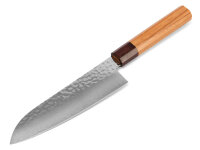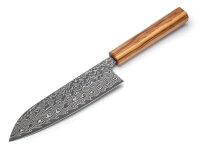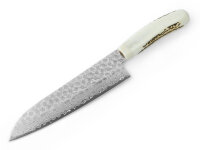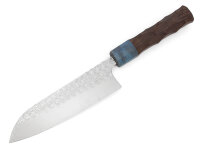"Damascus knife Santoku 180, 45 layers"
Takayuki, chef's knife from Sakai
Kyoto, the ancient imperial city, is known for its imperial high quality standards. Many connoisseurs consider Kyoto's cuisine the pinnacle of Japanese culinary art. Not only does it offer a taste that is appreciated worldwide, but the artful arrangement of the dishes is a real feast for the eyes. Preference is given to seasonally fresh foods. Even during preparation, the self-respecting Japanese chef takes care to treat the food in such a way as to bring out its freshness in color and texture. Sakai is located very close to Kyoto and is considered one of the most important knife strongholds in Japan. Excellent chef's knives are indispensable if the discerning cook wants to prepare food tastily and decoratively at the same time. Thus, the knife region has been able to contribute a great deal to the development of cooking culture in Kyoto with its first-class products. Sakai was called the Venice of the East at the beginning of the 16th century. As an important trading center, Sakai was one of the most prosperous cities in Asia. People from all over the world and all cultures met here with their products and knowledge. \"Everything new was born in Sakai,\" and the merchants and artisans took it back to other regions of Japan and inspired the people there.
Kitchen Knives of SAKAI TAKAYUKI
Brand
Japanese swords are a status symbol of ancient times. The blades were created by swordsmiths by folding and forging a carefully selected steel over and over again. Japan's ancient forging skills resulted in unprecedentedly brilliant and sharp blades. All of Japan is proud of this traditional craft of the masters. And the now worldwide distribution and appreciation of Japanese kitchen knives shows that Japan is justly proud. Japanese kitchen knives have some peculiarities, starting with the steel, the processing and ending with the shapes. Basically, they were created to cut delicate foods very finely. This task is typical of Japanese cuisine, which attaches almost as much importance to the art of presenting food appetizingly, decoratively, as it does to excellent taste. Kitchen knives of the SAKAI TAKAYUKI brand are made entirely in the spirit of ancient tradition and represent the exceptional skills of Japanese masters. Under this traditional brand there are modern kitchen knives made of stainless steels and of course Hocho, the traditional Japanese knives. SAKAI knives are subject to the special quality standards of this knife city. A cooperative strictly ensures that only chef's knives that meet the stipulated quality characteristics are offered as SAKAI knives.
How to use
Japanese chef's knives are made of extremely hard steels and are forged and ground thinner than their European counterparts. Some of these knives have very finely ground cutting layers, making them more delicate and suitable only for soft cut foods. Please refer to the product details for information in this regard. In particular, knives with a very thin cutting edge and hollow grind are prone to chipping on the blade. These are excellent for fine cuts of soft cut material, but should be used with appropriate care. Sharpening on a whetstone usually produces an angled grind, which makes the edge more stable over time.
Breakouts on the cutting edge can also occur due to leverage forces as well as frozen cuttings, which significantly reduce the temperature of the steel. Leverage forces often occur when cutting material with bones, for example. Chipping on the cutting edge may need to be ground out by a professional.
The knife should always be guided straight with pulling or pushing cut, without much pressure. To maintain sharpness, avoid cutting on stone, glass or other hard surfaces. Never use \"sharpening steel\" for resharpening. Water sharpening stones are recommended (grit: 400-1200 for preliminary sharpening, 3000 for fine sharpening, 6000 or more to strip the blade) and a honing leather if necessary.
Please keep the knife away from children. These knives are extremely sharp, please be careful.
All products are unique, slight deviations from the exemplary picture are therefore possible.
Care instructions
When using knives made of delicate types of steel, such as Aogami, Shirogami or V-Toku, please clean them occasionally with a cloth and water even during prolonged use. However, acidic foods can still cause discoloration on these classic carbon steels. After use, please wash by hand with hot water and use a neutral dishwashing detergent if necessary. Please do not put the knife in the dishwasher under any circumstances. After cleaning, dry thoroughly, oil if necessary, and store in a well-ventilated area. Residual moisture can cause rust in non-stainless steels. See our posts on the ORYOKI Japan blog for product care.
Clean the knife by hand and do not use a dishwasher. Dry it thoroughly afterwards.
























